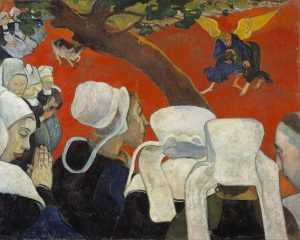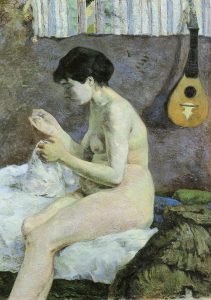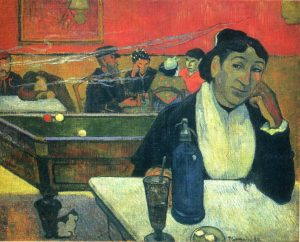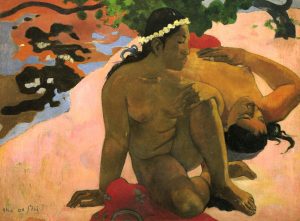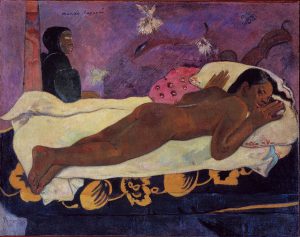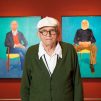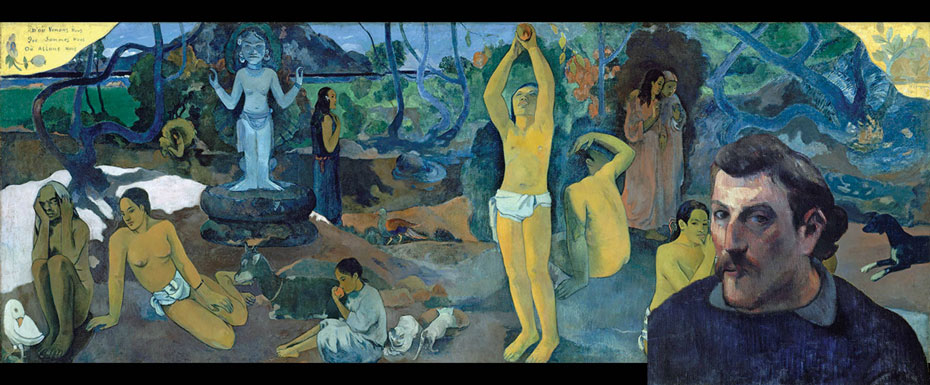
The full name of the French painter and printmaker, one of the creators of the synthetism movement in painting, dreamer, and rebel is Eugene Henri Paul Gauguin. He was French on his father’s side, while his mother came from a Peruvian family. Gauguin spent his childhood in Peru, whose exotic nature often inspired the artist for ideas in his work. However, drawing did not immediately become the main activity for Gauguin. His life was full of events that rather only pushed the artist to new discoveries and creativity.
Early Years
 From childhood, young Gauguin realized that he liked to spend time in nature and travel. Therefore, after working for several years as a clerk, he quit and intended to study at a nautical school. But the young man did not succeed in passing the exams, so he clung to the opportunity to travel to the most remote parts of the world as a sailor. Gauguin was not at home for 6 years, and on his return, with the assistance of a family friend, he got a job as a stockbroker. In general, the future genius of painting was doing great at this work. But because of the sudden onset of a crisis in the field, he decided to pay more attention to his old hobby, drawing, and begins to take private lessons from Camille Pissarro. The artist, however, never received a full specialized art education.
From childhood, young Gauguin realized that he liked to spend time in nature and travel. Therefore, after working for several years as a clerk, he quit and intended to study at a nautical school. But the young man did not succeed in passing the exams, so he clung to the opportunity to travel to the most remote parts of the world as a sailor. Gauguin was not at home for 6 years, and on his return, with the assistance of a family friend, he got a job as a stockbroker. In general, the future genius of painting was doing great at this work. But because of the sudden onset of a crisis in the field, he decided to pay more attention to his old hobby, drawing, and begins to take private lessons from Camille Pissarro. The artist, however, never received a full specialized art education.
Thus, in the early 1870s, Gauguin made his first steps towards the artist’s fame, and already in 1876, his first, albeit not very successful, exhibition of works was held. For ten years, Gauguin was gradually making creativity his life. It is interesting that he was married at that time and had five children, but his wife eventually got tired of the fact that her husband did not bring money to the family and left him with the children.
Paul Gauguin and Other Artists at the Origins of Synthetism
It is believed that synthetism as a style of painting emerged as an offshoot of post-impressionism. Its followers drew their paintings as the memory of something they saw in the past and often balanced on edge between the real and the fictional world. Synthetism-style canvases were characterized by bright colors and big spots.

The idea to create a new direction in the visual arts came to Gauguin together with Emile Bernard; Gauguin was very quickly bored with the framework with which European artists of that time restricted themselves. His creative nature wanted to find expression in a riot of colors and bright sunlight. Thus, after holding an exhibition of the works of the aforementioned artists in Paris, synthetism began its existence in 1889.
Other followers of synthetism were part of the so-called Pont-Aven group. The most famous followers of the movement, in addition to Gauguin, were Charles Laval, Louis Anquetin, Paul Serusier, and its features were also traced in the works of Paul Serusier, Henry Moret, Jan Verkade, Armand Séguin, and others.
Gauguin’s Merging with Nature and Productive Years
1887 was a breakthrough year for the artist himself and his work. He finally found himself in the conditions that maximally contribute to his creativity. He went to Panama and then to Tahiti, where by 1892, he managed to paint 80 paintings. Among the masterpieces of this time, the Sewing Woman, the Vision after the Sermon, the Cafe in Arles, the Yellow Christ, the Woman with the Flower, the Spirit of the Dead Does Not Sleep, and Are You Jealous? can be mentioned.
The history of the last picture is especially interesting. It was dedicated to the artist’s second wife, who at the time of the wedding was only 13 years old. But Gauguin was too fond of a riotous lifestyle, and therefore, two years later, their union broke up. The girl and the artist’s life in Haiti can be found in his autobiographical novel Noa Noa: The Tahitian Journal, written in the islands.
Last Decade
 In 1893, Gauguin decided to show his work to the high society and returned to France. However, the public did not show any particular enthusiasm for his paintings, and the artist did not manage to earn money. By the way, Gauguin’s life was also significantly poisoned by syphilis, which he contracted during his adventures in tropical regions. The artist decided to distance himself from people again and went to Oceania. There he even tried to commit suicide but still, the craving for drawing won. He spent his last years in the Marquesas Islands and died in 1903 at the age of 54.
In 1893, Gauguin decided to show his work to the high society and returned to France. However, the public did not show any particular enthusiasm for his paintings, and the artist did not manage to earn money. By the way, Gauguin’s life was also significantly poisoned by syphilis, which he contracted during his adventures in tropical regions. The artist decided to distance himself from people again and went to Oceania. There he even tried to commit suicide but still, the craving for drawing won. He spent his last years in the Marquesas Islands and died in 1903 at the age of 54.
The fate of Gauguin as an artist became similar to his friend, van Gogh, with whom he communicated at a certain point in his life until van Gogh’s condition worsened. Three years after the death of Gauguin, the real success came to his paintings after the exhibition in Paris. Misunderstood by his peers, Gauguin’s legacy has had a great influence on generations of artists to come, including contemporary art.


